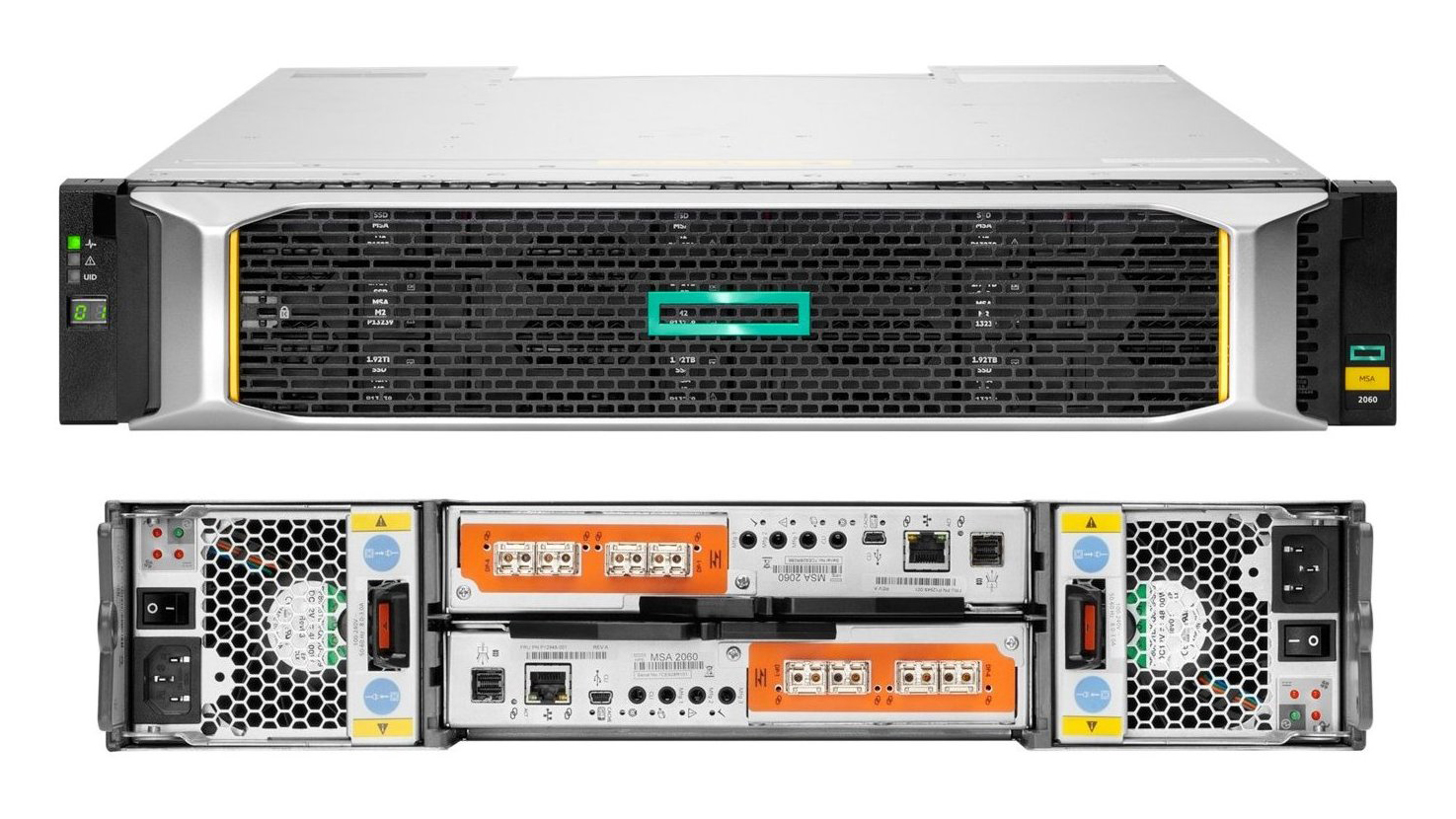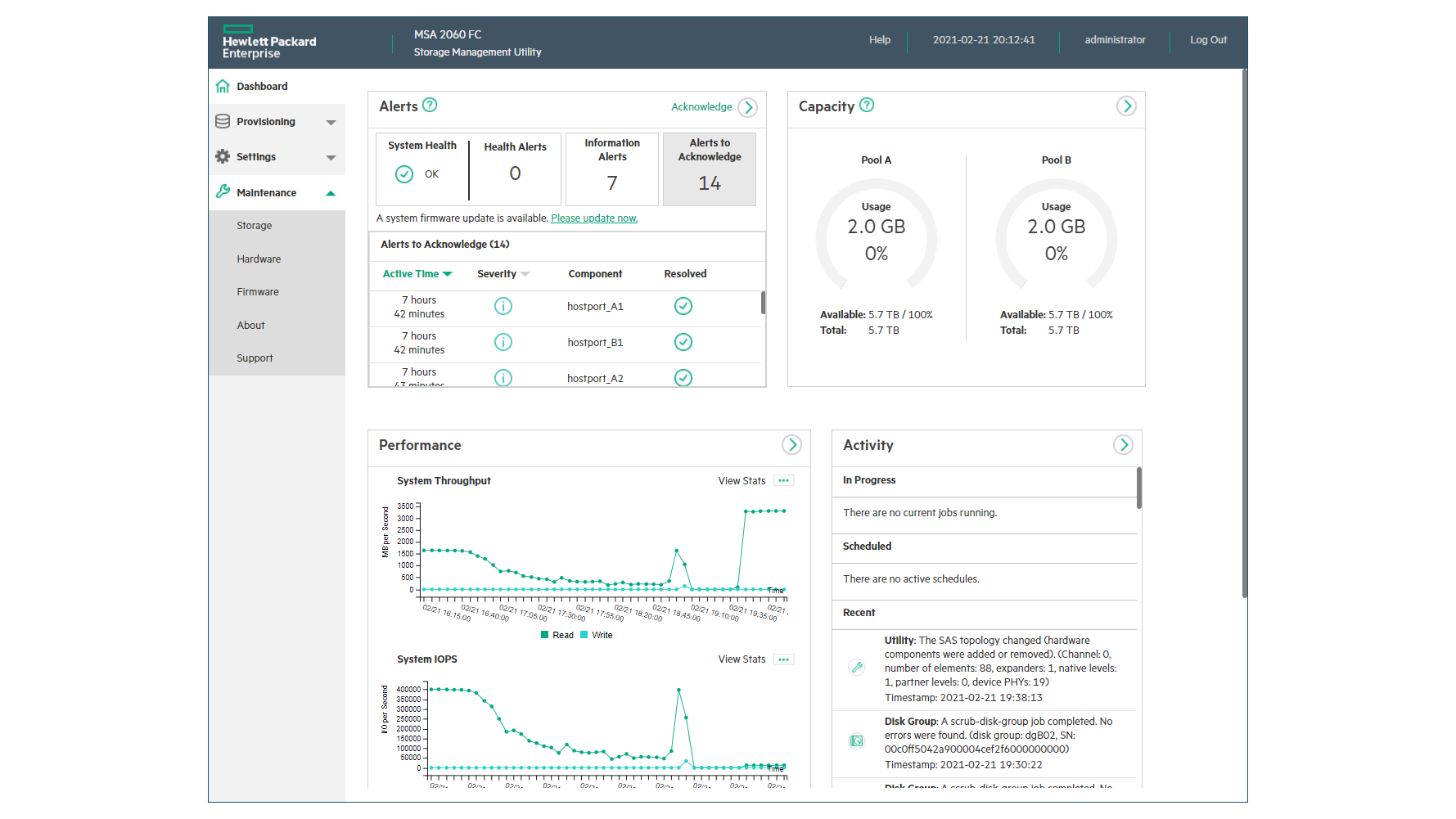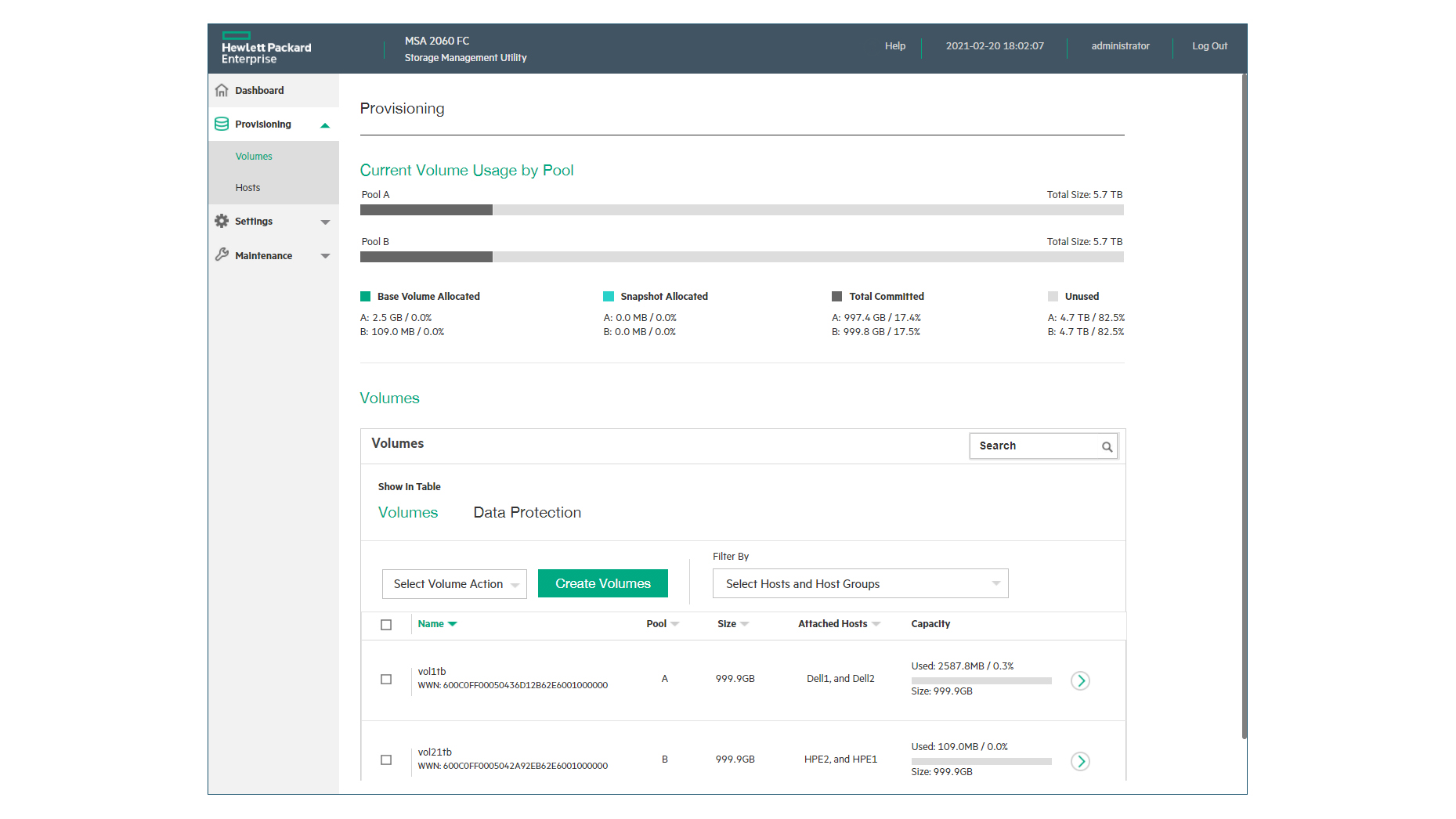HPE MSA 2060 Storage review: Storage tiering for dummies
HPE’s affordable Gen6 MSA 2060 array boosts storage performance for SMBs


-
+
Top value
-
+
Easy deployment
-
+
Real-time data tiering
-
+
Great FC performance
-
+
High storage expansion potential
-
-
No converged controllers

HPE’s MSA storage arrays have always had a firm focus on SMBs and the latest Gen6 2060/2062 models aim to deliver more power for even less cash. Their uprated ASIC and larger cache memory claim up to 45% IOPS and 75% sequential throughput increases over the previous Gen5 2050/2052 arrays, and the latest firmware brings in a number of valuable new features.
As with previous models, the new MSAs come with dual controllers running in active/active mode and their cache capacities go from 8GB to 12GB per controller. There’s no need for batteries to protect the cache contents in the event of a power failure either, as each controller employs a fast charging super-capacitor and CompactFlash card.
A significant change, however, is the new controllers no longer offer converged host ports. Whereas the 2050/2052 arrays allowed you to install the desired transceivers to set their personality, the 2060/2062 versions must be ordered with either 8/16Gbps FC or 10GbE iSCSI host ports – HPE also offers a 12Gbps SAS3 direct-attach option.
The arrays are available with 12 LFF or 24 SFF hot-swap drive bays supporting SAS3 and Midline SAS (ML-SAS) HDDs and SAS3 SSDs. Expansion potential also sees big improvements; the port on each controller goes from SAS2 to SAS3 and supports up to nine disk shelves for a total of 240 drives, bringing a disk density increase of 25% over the Gen5 arrays.
HPE MSA 2060 Storage review: Storage features
On review is the MSA 2060 Storage FC model, which comes with four 8/16Gbps FC host ports per controller. The software offers plenty of standard storage features including thin provisioning, snapshots, volume copies and SSD read caching.
Storage pool RAID options are extensive, with support for striped SSD read caches plus standard mirrors, RAID10, 5 and 6 arrays. HPE also introduces its own MSA-DP+ virtual disk groups which support from 12 to 120 disks and are designed to improve performance and provide faster rebuild times.
HPE’s data tiering supports a performance tier of SSDs, a standard tier of enterprise SAS drives and an archive tier of ML-SAS drives. The smart bit is all page moves between the tiers are fully automated, allowing the array to respond quickly to changes in I/O patterns.

The standard and archive tiers are included by default on the MSA 2060, but the performance tier is optional and requires HPE’s MSA Advanced Data Services Suite (ADSS) license applied. Included with the 2062, it’s worth having as it also increases the number of volume snapshots from 64 to 512 and activates the remote snap service for asynchronous replication to remote MSA arrays.
HPE MSA 2060 Storage review: Deployment
When we reviewed the MSA 2052 we thought installation was easy enough, but HPE has simplified it even further. On first contact with the new SMU v4 web interface, it kicked off with a wizard that guided us through system setup, securing management access, creating storage pools, provisioning virtual volumes and setting data port host assignments.
The controllers support one storage pool apiece which can be up to 1PB in capacity. Each contains multiple disk groups which are created by selecting disk types, RAID levels and the controller you want to assign them to.
Our review system had the ADSS license applied so when we assigned a dual SSD mirror to a pool, it was automatically placed in a performance tier while our SAS3 HDD arrays went into a standard tier. If you don’t have the ADSS license, you can still use SSDs to create a read cache and assign it to a pool.
Creating virtual volumes is a cinch. We simply chose the controller to determine the pool they would go in, provided a name, entered a size in MB, GB or TB and assigned them to specific host data ports. Snapshots are created by selecting the data protection option for a volume and running them on-demand, or applying a schedule where they can be repeated as often as every minute.
HPE MSA 2060 Storage review: Performance
For performance testing, we used Dell and HPE dual-socket Xeon Scalable servers running Windows Server 2019 and equipped with quad-port 16Gbps FC ATTO Celerity HBAs. Over on the MSA 2060, we created two pools, each with a dual SSD mirrored performance tier and a RAID5 standard tier made up of five 10K SAS3 HDDs.

When creating MPIO links, bear in mind that the array uses an asymmetric active/active mode. If you connect a host to each controller, you don’t get a doubling in performance, as the link to the controller that doesn’t own the pool is designated as non-optimised and reserved for automatic failover.
With one server connected across both controllers and assigned a 1TB volume from Pool A, we started Iometer and watched all activity shift over to the SSD performance tier in around 5 minutes. Sequential read and write performance were both measured at a steady 12.3Gbits/sec while random rates settled at an equally speedy 12Gbits/sec and 7.4Gbits/sec.
Assigning a 1TB volume from Pool B to our second server saw cumulative sequential read and write speeds for both servers ramp up to 24.6Gbits/sec with random rates increasing to 19.1Gbits/sec and 14.8Gbits/sec. Cumulative IOPS were equally good - Iometer reported 640,000 and 178,500 IOPS for sequential reads and writes, with random operations returning 398,500 and 111,000 IOPS.
HPE MSA 2060 Storage review: Verdict
Although we tested HPE’s MSA 2052 Storage over 10GbE iSCSI, we can still see that the Gen6 MSA 2060 FC model and its uprated hardware and larger cache delivers significant performance improvements across the board. It retains all the features that make it appealing to SMBs such as ease of deployment and automated data tiering, it offers an even greater expansion potential and the comparatively low starting price makes it extremely good value.
HPE MSA 2060 Storage specifications
| Chassis | 2U rack |
| Storage | 24 x SAS3 SFF hot-swap bays (no drives included) |
| Power | 2 x 580W hot-plug PSUs with cooling fans |
| Controllers | Dual active/active controllers each with the following: |
| CPU | HPE ASIC |
| Memory | 12GB cache with super-capacitor and CompactFlash card |
| Array support | RAID 0 (read cache only), 1, 5, 6, 10, MSA-DP+ |
| Network | Gigabit management port |
| Host ports | 4 x 8/16Gbps Fibre Channel |
| Management | Web browser |
| Expansion | SAS3 port |
| Options | HPE Advanced Data Services Suite license – from £428 exc VAT |
| Warranty | 3-year limited parts only exchange NBD response |
Get the ITPro daily newsletter
Sign up today and you will receive a free copy of our Future Focus 2025 report - the leading guidance on AI, cybersecurity and other IT challenges as per 700+ senior executives
Dave is an IT consultant and freelance journalist specialising in hands-on reviews of computer networking products covering all market sectors from small businesses to enterprises. Founder of Binary Testing Ltd – the UK’s premier independent network testing laboratory - Dave has over 45 years of experience in the IT industry.
Dave has produced many thousands of in-depth business networking product reviews from his lab which have been reproduced globally. Writing for ITPro and its sister title, PC Pro, he covers all areas of business IT infrastructure, including servers, storage, network security, data protection, cloud, infrastructure and services.
-
 ‘Phishing kits are a force multiplier': Cheap cyber crime kits can be bought on the dark web for less than $25 – and experts warn it’s lowering the barrier of entry for amateur hackers
‘Phishing kits are a force multiplier': Cheap cyber crime kits can be bought on the dark web for less than $25 – and experts warn it’s lowering the barrier of entry for amateur hackersNews Research from NordVPN shows phishing kits are now widely available on the dark web and via messaging apps like Telegram, and are often selling for less than $25.
By Emma Woollacott Published
-
 Redis unveils new tools for developers working on AI applications
Redis unveils new tools for developers working on AI applicationsNews Redis has announced new tools aimed at making it easier for AI developers to build applications and optimize large language model (LLM) outputs.
By Ross Kelly Published
-
 Google layoffs continue with "hundreds" cut from Chrome, Android, and Pixel teams
Google layoffs continue with "hundreds" cut from Chrome, Android, and Pixel teamsNews The tech giant's efficiency drive enters a third year with devices teams the latest target
By Bobby Hellard Published